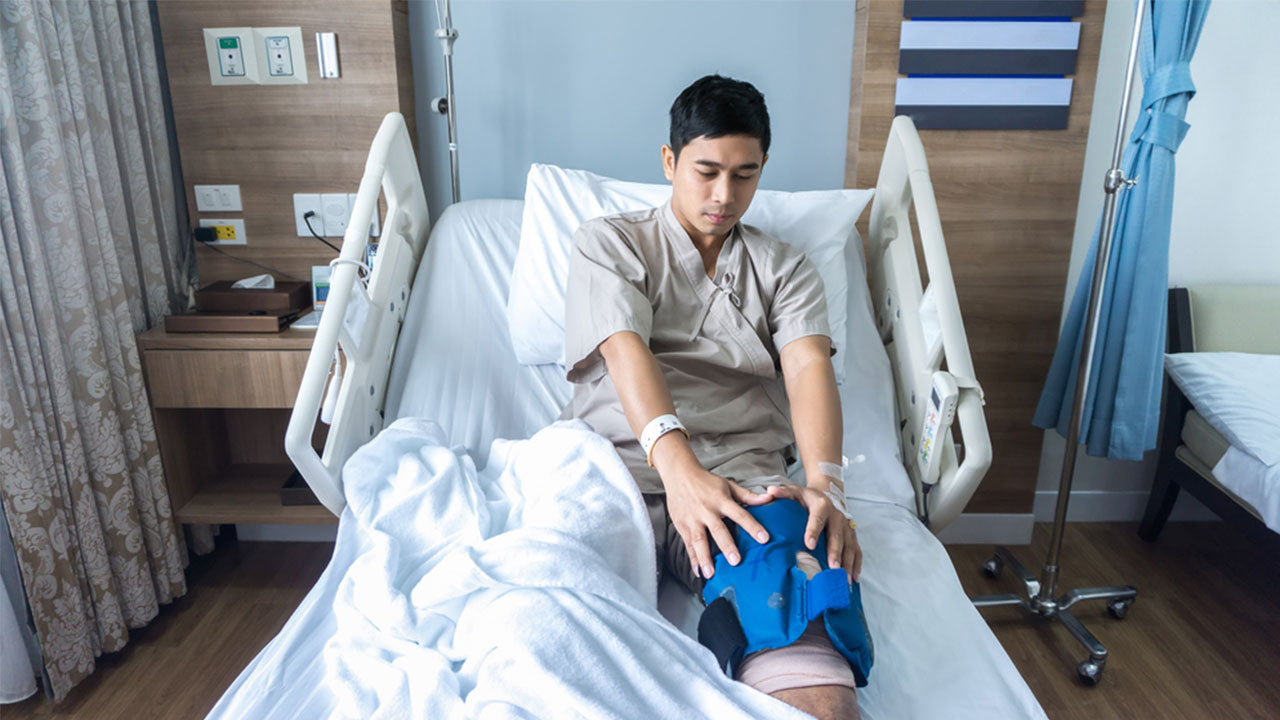What to Expect After Knee Replacement Surgery
 By: by Amino Science
By: by Amino Science

Total knee replacement surgery, also called total knee arthroplasty, can have you down for the count for at least 6 weeks. Here’s what to expect after knee replacement surgery, as well as scientifically validated ways to speed recovery so you can get back to doing what you love and doing it stronger than ever.
Why Get Knee Replacement Surgery?
If you suffer from osteoarthritis, a type of arthritis that progressively wears down the protective tissues at the ends of bone (cartilage), then the pain may be too much to bear and warrant knee replacement surgery. Rheumatoid arthritis may have destroyed the knee joint to the point that you are experiencing debilitating pain and/or deformity. If function has become severely compromised and you have difficulty walking, climbing stairs, or getting in and out of chairs, knee replacement surgery may also be called for.
An orthopedic surgeon will examine your X-rays to assess the damage and will check your stability, strength, and range of motion in order to determine if you are a candidate for surgery.
During knee replacement surgery damaged cartilage and bone is cut away from the kneecap, thighbone, and shinbone, and replaced with a primarily metal implant (or prosthesis) made up of high-grade plastics, polymers, and metal parts. Depending on the surgical technique, you'll be under general anesthesia or regional anesthesia in which strategic nerve blocks temporarily disable your pain receptors, for approximately 2 hours.
Statistics from the American Academy of Orthopaedic Surgeons (AAOS) paint a positive light on recovery from total knee replacement. Approximately 90% of patients report significant pain relief and are able to return to physical activities they couldn’t do before surgery, including patients with severe arthritis or traumatic arthritis due to injury. The AAOS also reports that 90% of artificial knees are still working after 15 years, and 82% after 25 years.
If knee pain from knee arthritis or knee injury is reducing your quality of life and limiting mobility, then a visit to an orthopedic surgeon is your first stop.
Preparing for Knee Replacement Surgery
Having a recovery and rehabilitation plan in place will help reduce your hospital stay, accelerate strength and mobility gains, and improve your overall outcomes. The key to preparation is following all the pre- and post-surgery guidelines your doctor gives you.
In addition to making sure your space is clear of any loose cords, rugs, or other tripping hazards, here’s a preparation list to have at the ready so that your recovery is as smooth, speedy, and pain-free as possible:
- A ride to and from the hospital
- A family member or professional health aid to help with cooking, cleaning, bathing, etc.
- A walker or crutches
- A downstairs bedroom or cot for your convalescence
- Remotes, books, water, medications, etc. at your bedside
- Safety bars or a secure handrail in the shower or bath
- Secure stairway handrails
- Chair with firm seat cushion and back, and footstool for elevation
- Bench or chair for shower
- Toilet-seat riser for a low toilet
Your surgeon may also prescribe a continuous passive motion (CPA) machine that slowly straightens and bends the affected leg while you lay on your back or sit halfway upright. It can be used for up to 8 hours a day between physical therapy sessions and sleeping and has been shown to help patients regain range of motion faster.
What to Expect After Knee Replacement Surgery
After surgery, expect to spend a couple of hours in a recovery room before moving to your hospital room where you will be monitored and given pain medications. You’ll begin your physical therapy ASAP by moving your ankle and foot to boost blood flow to the leg muscles and knee joint and help prevent blood clots and swelling. Your doctor will likely prescribe blood thinners and compression hoses or boots as added protection against clotting and swelling.
Within 24 hours you will be asked to stand and take a few steps with the aid of a physical therapist or a walker. Physical therapy in the hospital will continue with breathing exercises and an uptick in physical activity. Your physical therapist will teach you rehabilitation exercises for you to continue with at home or at an outpatient center.
Recovery times vary according to the surgical procedure—total knee replacement, partial knee replacement (unicompartmental), kneecap replacement, or complex (revision) knee replacement—but patients are usually able to leave the hospital within 1-5 days. Doctors will typically discharge a patient when they can get in and out of bed and walk 100-300 feet with a walker or crutches, and when they can bend their knee 80-90 degrees.
Whether you are discharged to your home or a short-term care facility due to rehabilitation challenges is up to your doctor. We recommend that you call in advance to review your insurance options.
Watch for Risk of Infection
Knee surgery comes with risks that include blood clots in the leg vein (deep vein thrombosis), blood clots in the lungs, stroke, heart attack, nerve damage, and infection.
Stay vigilant to the signs of infection:
- Fever
- Chills
- Shaking
- Drainage from surgical site
- Increased swelling, tenderness, or redness
- Increased pain

Results and Recovery Timeline
The 3- to 6-week mark is the recovery sweet spot for most knee implant patients. Daily activities can be resumed gingerly and you may be able to drive if you’ve regained your pre-surgery reflexes and muscle strength and are not on any narcotic pain meds that would put you or others in danger. Most knee replacement patients are 90% recovered and able to get back to normal activities in 3 months, but 100% recovery may take up to 6 months.
You’ll be exercising throughout your recovery and following the regimen developed by your physical therapist according to AAOS guidelines (at orthoinfo.aaos.org). This could mean exercising for 20–30 minutes, 3 times a day or walking for 30 minutes up to 3 times a day.
As recovery progresses, you can perform low-impact exercises and non-contact sports, such as swimming, walking, biking, and golfing. If there is a particular activity you love, consult with your physician first, particularly if it is high impact or potentially hard on the joints. You’ll likely feel better than ever with your new knee, but want to do everything possible to avoid reinjury.
If you have a sedentary job, then plan to return to work 4-6 weeks after joint replacement surgery. If you participate in mixed labor jobs, such as teaching, then plan for 3 months out. Manual labor jobs that put continual pressure on your knees are not recommended to return to, as the wear and tear is a common reason for knee injury.
How to Speed Recovery from Knee Replacement Surgery
- Recovery rule #1: Follow the guidance of your knee surgeon! That means sticking to weight-bearing guidelines and your rehabilitation program and going to every follow-up appointment.
- Recovery rule #2: Take your pain management medication as prescribed. If you are in too much pain you will be unable to engage in your rehabilitation exercises and the swelling could prohibit you from regaining full mobility and range of motion.
- Recovery rule #3: Do your strength-training exercises. Evidence even shows that knee-strengthening exercises before surgery help to accelerate recovery.
- Recovery rule #4: Support healing with nutrition. Supplementing with amino acids before and after knee surgery or hip replacement surgery has been proven to lessen muscle atrophy, increase functional mobility, and improve patient rehabilitation outcomes (1).
The precise formula of amino acids proven to accelerate the recovery process and mitigate muscle loss can only be found in Heal, The Amino Company’s surgical recovery blend. You can learn more about Heal and stock up before your surgery, here.

Up to 25% off Amino
Shop NowTAGS: #surgery
Join the Community
Comments (0)
Most Craveable Recipes





 833-264-6620
833-264-6620



















